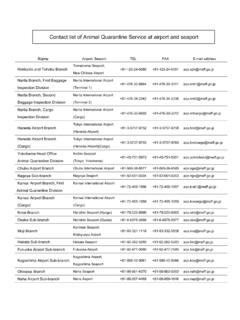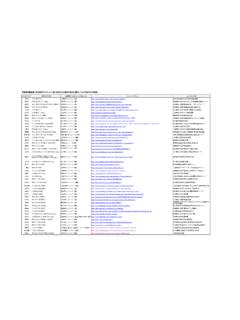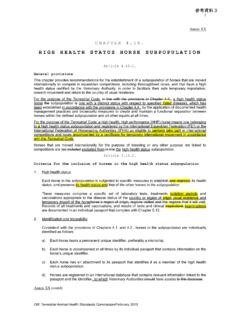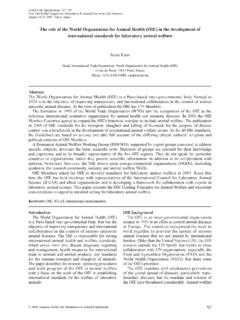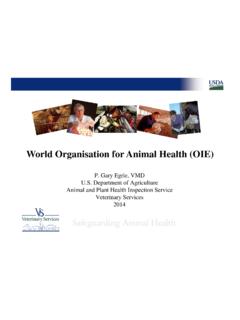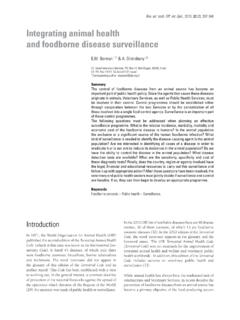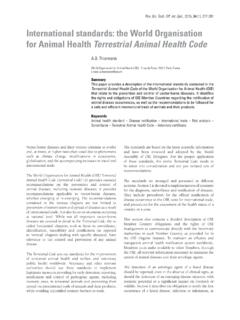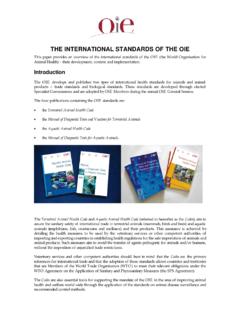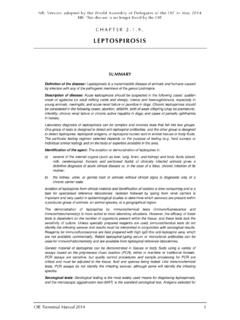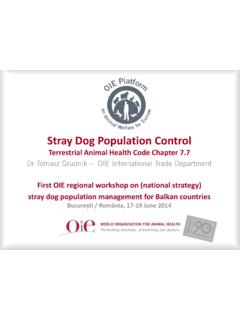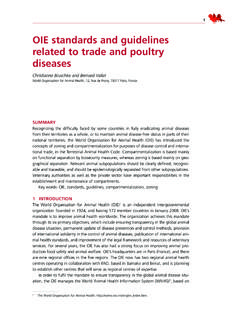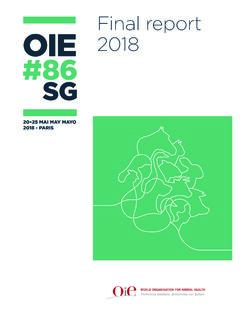Transcription of ANIMAL WELFARE AND PIG PRODUCTION SYSTEMS - …
1 1 OIE terrestrial ANIMAL health Standards Commission/September 2016 Annex 27 DRAFT CHAPTER ANIMAL WELFARE AND PIG PRODUCTION SYSTEMS Article Definitions Pig PRODUCTION SYSTEMS are defined as all commercial SYSTEMS in which the purpose of the operation includes some or all of the breeding, rearing and management of pigs intended for PRODUCTION of meat. For the purpose of this chapter, management is defined at the farm management level and at the ANIMAL handler level. At the level of farm management, human resources management practices including selection and training, and ANIMAL management practices, such as best practice in housing and husbandry and implementation of WELFARE protocol and audits, all impact on ANIMAL WELFARE . At the ANIMAL handler level this requires a range of well-developed husbandry skills and knowledge to care for animals.
2 For the purpose of this chapter, environmental enrichment means increasing the complexity ( foraging opportunities, social housing) of the ANIMAL s environment to foster the expression of normal behaviour and reduce the expression of abnormal behaviour and provide cognitive stimulation. The endpoint of enrichment should be to improve the biological functioning of the ANIMAL (Newberry, 1995). Article Scope This chapter addresses the WELFARE aspects of pig PRODUCTION SYSTEMS . However, captive wild pigs are not considered. Article Commercial pig PRODUCTION SYSTEMS Commercial pig PRODUCTION SYSTEMS include: 1. Indoors These are SYSTEMS in which pigs are kept indoors, and are fully dependent on humans to provide for basic ANIMAL needs such as food and water.
3 The type of housing depends on the environment, climatic conditions and management system . The animals may be kept in groups or individually. 2. Outdoors These are SYSTEMS in which pigs live outdoors with shelter or shade, have some autonomy over access to shelter or shade, and may be fully dependent on humans to provide for basic ANIMAL needs such as food and water. They are typically confined in paddocks according to their PRODUCTION stage. 3. Combination SYSTEMS These are SYSTEMS in which pigs are managed in any combination of indoor and outdoor PRODUCTION SYSTEMS , depending on weather or PRODUCTION stage. 2 OIE terrestrial ANIMAL health Standards Commission/September 2016 Annex 27 (contd) Article Criteria (or measurables) for the WELFARE of pigs The following outcome-based criteria, specifically ANIMAL -based criteria, can be useful indicators of ANIMAL WELFARE .
4 The use of these indicators and their appropriate thresholds should be adapted to the different situations in which pigs are managed. Consideration should also be given to the design of the SYSTEMS . These criteria can be considered as a tool to monitor the efficiency of design and management, given that both of these can affect ANIMAL WELFARE . 1. Behaviour Certain behaviours could indicate an ANIMAL WELFARE problem. These include changes of feed and water intake, altered locomotory behaviour and posture, altered lying time, altered respiratory rate and panting, coughing, shivering and huddling, increased agonistic behaviours and stereotypic, apathetic or other abnormal behaviours ( tail biting). Stereotypy is defined as a sequence of invariant motor acts, which provide no obvious gain or purpose for the ANIMAL .
5 Some stereotypies commonly observed in pigs include sham chewing, tongue rolling, teeth grinding, bar biting and floor licking. 2. Morbidity rates Infectious and metabolic diseases, lameness, peri-partum and post-procedural complications, injury and other forms of morbidity, above recognised thresholds, may be direct or indirect indicators of the ANIMAL WELFARE status of the whole herd. Understanding the aetiology of the disease or syndrome is important for detecting potential ANIMAL WELFARE problems. Mastitis and metritis, leg and hoof, and reproductive diseases are also particularly important ANIMAL health problems for pigs. Scoring SYSTEMS , such as for body condition, lameness and injuries, provide additional information.
6 Both clinical examination and pathology should be utilised as indicators of disease, injuries and other problems that may compromise ANIMAL WELFARE . 3. Mortality and culling rates Mortality and culling rates affect the length of productive life and, like morbidity rates, may be direct or indirect indicators of the ANIMAL WELFARE status. Depending on the PRODUCTION system , estimates of mortality and culling rates can be obtained by analysing the causes of death and culling and their temporal and spatial patterns of occurrence. Mortality and culling rates, and their causes, when known, should be recorded regularly, daily, and used for monitoring monthly, annually. Necropsy is useful in establishing the cause of death.
7 4. Changes in body weight and body condition In growing animals, body weight changes outside the expected growth rate, especially excessive sudden loss, are indicators of poor ANIMAL WELFARE and health . In mature animals, body condition outside an acceptable range may be an indicator of compromised ANIMAL WELFARE , health and reproductive efficiency. 5. Reproductive efficiency Reproductive efficiency can be an indicator of ANIMAL WELFARE and health status. Future performance of sows or gilts can be affected by under- or over-nutrition at different stages of rearing. Poor reproductive performance, compared with the targets expected for a particular breed or hybrid, can indicate ANIMAL WELFARE problems. 3 OIE terrestrial ANIMAL health Standards Commission/September 2016 Annex 27 (contd) Examples may include: low conception rates, high abortion rates, metritis and mastitis, low litter size, low numbers born alive, high numbers of stillborns or mummies.
8 6. Physical appearance Physical appearance may be an indicator of ANIMAL WELFARE and health . Attributes of physical appearance that may indicate compromised WELFARE include: presence of ectoparasites, abnormal texture or hair loss, excessive soiling with faeces in indoor SYSTEMS , swellings, injuries or lesions, discharges ( from nose or eyes), feet and leg abnormalities, abnormal posture ( rounded back, head low), emaciation or dehydration. 7. Handling response Improper handling can result in fear and distress in pigs. Fear of humans may be an indicator of poor ANIMAL WELFARE and health . Indicators include: evidence of poor human- ANIMAL relationship, such as disturbed behaviour when being moved or when ANIMAL handlers enter a pen, animals slipping or falling during handling, injuries sustained during handling, such as bruising, lacerations and fractured legs, animals vocalising abnormally or excessively during restraint and handling.
9 8. Lameness Pigs are susceptible to a variety of infectious and non-infectious musculoskeletal disorders. These disorders may lead to lameness and to gait abnormalities. Pigs that are lame or have gait abnormalities may have difficulty reaching food and water and may experience pain. Musculoskeletal problems have many causes, including genetic, nutrition, sanitation, floor quality, and other environmental and management factors. There are several gait scoring SYSTEMS available. 9. Complications from common procedures Some procedures such as surgical castration, tail docking, teeth clipping or grinding, tusk trimming, identification, nose ringing and hoof care are commonly performed in pigs to facilitate management, to meet market requirements and improve human safety and ANIMAL WELFARE .
10 However, if these procedures are not performed properly, ANIMAL WELFARE and health can be compromised. 4 OIE terrestrial ANIMAL health Standards Commission/September 2016 Annex 27 (contd) Indicators of such problems include: post-procedure infection and swelling, post-procedure lameness, behaviour indicating pain, fear and distress, morbidity, mortality and culling rates, reduced feed and water intake, post procedure body condition and weight loss. Article Recommendations Ensuring good WELFARE of pigs is contingent on several management factors, including system design, environmental management, and ANIMAL management practices which include responsible husbandry and provision of appropriate care. Serious problems can arise in any system if one or more of these elements are lacking.
